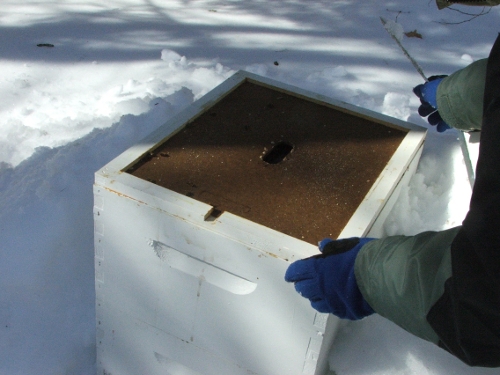I waited impatiently for that “warm” day when I can go out to the hive and do a quick inspection. 40-45 F is the minimum advised temperature at which you can open the cover, have a very quick look, deposit any food on top of the bars, and close it up. No more.
In preparation I read up on what I could possibly find in there (it is, after all, my first Winter as a beekeeper) and what to do under which circumstances. I made a sugar fondant that I poured into molds, defrosted a pollen substitute patty, and made a spacer rim which will keep the cover from squishing the food.
Sugar Fondant Recipe

First, make a 2:1 syrup (white granulated sugar:water, by weight) (don’t let it boil but make sure all the sugar is dissolved)
Then, make sugar fondant, which is 4 parts 2:1 syrup, 4 parts white sugar, 3 parts water, by volume. First see how many cups of sugar syrup you have, take it from there.
- boil the water
- gradually add the sugar and the syrup until dissolved (not difficult).
- let the temp go up to 238 F. This takes a while if your lid doesn’t fit the pot well and it keeps releasing heat, which it will if your thermometer sticks out. I wrap a towel around the lid and thermometer to keep as much heat in as possible. Â Keep an eye on it: let it go higher and you’ll have caramelized sugar which will give your bees dysentery. When it reaches 238F, immediately take off lid, remove put from off heat, and stir to cool it down again.
- let cool down without disturbing it until it’s warm to the touch
- then mix briskly (it should lighten in color)
- I also add Honey-Bee-Heatlhy (1 tsp for 1 quart)
- pour into waxed mold – make ’em thin so they fit the rim space.
For a spacer rim you can use an unused landing board like below or you can quickly make one.
Today it registered a whopping 50 F, the hive was in the sun, and there was no wind. DH came along to take pictures and help.
I didn’t know what to expect. I saw some bees flying out a few weeks ago, and there were signs of undertaking (dead bee clean out), but I had no idea of the strength of the colony, its numbers, its food supply. We went out without veils, and without bee gloves. Here is the hive after clearing off the snow, removing the outer cover and the queen excluder I had put on top of the inner cover to keep the mice out.
As soon as I cracked the inner cover open with my hive tool…
Just lovely! What a wonderful surprise!
I kept my cool even though I soon had about a hundred bees flying at my face, stinging my gloves. But what to do? No time to run inside to get a veil. If you get stung it’s no big deal, Â but if you leave the hive open for too long, they all die. Forge on!
The nest is up on top, to the front. There were many bees, though I dare not guess how many. They seemed strong. I didn’t have much time to look closely, but I didn’t see any honey in the frames surrounding them, so it was good that I came out with the food. I brushed some of the bees off the top and placed the spacer. In this picture you can see the bees attacking my gloves.
Then I deposited half the fondant and half the pollen patty on top, a little to the side of the nest.
Then I felt this frantic buzzing in my sleeve. I quickly brushed the bees that were still on the inner cover into the hive and replaced it, then added the outer cover. Then I ripped off my jacket. Whew! It must have looked pretty funny to someone observing us.
Soon lots of bees were flying out of the top opening. To keep the nest clean they don’t defecate for weeks at a time. A warm day like this allows them relieve themselves. Our jackets and the snow all around was spotted with that vile stuff. Time for laundry.
There was also a lot of cleaning out dead bees.
My gloves with some bees stuck to it by their stingers.
But here I am, miraculously unstung, and very, very happy.
Hurray for the bees!












Leave a comment